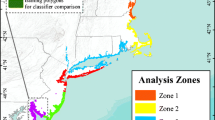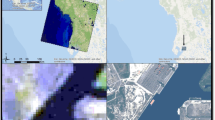Abstract
Advances in technology and decreases in cost are making remote sensing (RS) and geographic information systems (GIS) practical and attractive for use in coastal resource management. They are also allowing researchers and managers to take a broader view of ecological patterns and processes. Landscape-level environmental indicators that can be detected by Landsat Thematic Mapper (TM) and other remote sensors are available to provide quantitative estimates of coastal and estuarine habitat conditions and trends. Such indicators include watershed land cover, riparian buffers, shoreline and wetland changes, among others. With the launch of Landsat 7, the cost of TM imagery has dropped by nearly a factor of 10, decreasing the cost of monitoring large coastal areas and estuaries. New satellites, carrying sensors with much finer spatial (1–5 m) and spectral (200 narrow bands) resolutions are being launched, providing a capability to more accurately detect changes in coastal habitat and wetland health. Advances in the application of GIS help incorporate ancillary data layers to improve the accuracy of satellite land-cover classification. When these techniques for generating, organizing, storing, and analyzing spatial information are combined with mathematical models, coastal planners and managers have a means for assessing the impacts of alternative management practices.
Similar content being viewed by others
Author information
Authors and Affiliations
Rights and permissions
About this article
Cite this article
KLEMAS, V. Remote Sensing of Landscape-Level Coastal Environmental Indicators. Environmental Management 27, 47–57 (2001). https://doi.org/10.1007/s002670010133
Issue Date:
DOI: https://doi.org/10.1007/s002670010133




